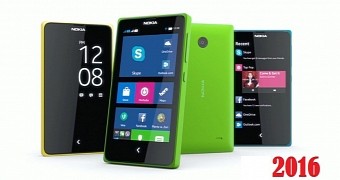There has been a lot of fuss about Nokia lately. First off, the Finnish company announced that it was purchasing the French telecom equipment maker Alcatel Lucent for the sum of $16.6 / €15.6.
On top of that, Nokia claimed it was in the process of reviewing its HERE Maps business, which it might even end up selling. As revealed in recent reports, titans of the industry such as Apple, Facebook and Amazon are looking into the acquisition.
But the biggest news came towards the end of this week, when Nokia officially confirmed it was planning to release its next Android smartphone in 2016.
However, Nokia’s new mobile efforts won’t look anything like its original business. The company will develop in-house products and then license the design and the company’s brand name to a third-party manufacturer.
Since Microsoft purchased Nokia back in 2013, the Finnish company is prohibited from licensing its brand on smartphones until the end of 2016.
Nokia is taking up Android smartphone building once again
Even so, the device maker has come with this workaround for the situation and is actively pushing the development of its next-gen Android smartphone.
So what should we expect to see in 2016 when Nokia is finally ready to take the stage and present us with its first post-Microsoft acquisition era product?
As we already told you above, Windows is an option that won’t be used by Nokia anymore. The company already tried its hand at it and failed miserably. So the next logical step is to move towards the Android ecosystem.
Actually, Nokia already launched a product with Android on board in 2014, in the form of the N1 tablet, following the pattern I just described: it licensed the product design and brand name to a third-party player.
So if we want to imagine Nokia’s mobile future in 2016, we might find some worthy clues by looking at the N1 tablet. The slob arrived with a 7.9-inch display (in the vein of the iPad) with an advanced 2046 x 1536 pixel resolution.
Under the hood, Nokia used an Intel Atom Z3580 Silvermont quad-core processor running at 2.3GHz, the same one that is powering ASUS’ new ZenFone 2 smartphone, the first in the world to arrive with 4GB of RAM.
The slate also comes with 2GB of RAM, 32GB of internal storage, and an 8MP rear camera. Having arrived on the market with a $259 / €238 price tag, the Nokia N1 quickly became a hit, selling the first 20,000 unit batch in just a few minutes.
Nokia is probably prepping a premium device for 2016
So what conclusions can be drawn just by looking at the N1? First of all, Nokia will probably step away from the design schematics characteristic of its former Lumia branch.
Sure, the Lumias were an atypical bunch of smartphones, but Nokia needs to come up with something new if it wants to draw customers back in. And the N1 was a good start, arriving with its anodized aluminum body and smooth rounded corners reminiscent of today’s popular tablets.
Nokia might also want to conjure the days of old, by making an Android smartphone that’s sturdy and ever-lasting. After all, endurance was one of the best-known characteristics of the Nokia product lineup.
Next stop, hopefully we’ll see the Finnish company keep using great camera technology in its smartphones. The Carl Zeiss partnership allowed Nokia to launch some Lumia models with impressive camera capabilities.
But maybe Nokia is looking to start clean in 2016, so Carl Zeiss might be scraped off from the equation. Nevertheless, the camera department is an important aspect to consider, and with Nokia’s track record of focusing on embedding advanced snapper tech, we have high hopes.
Although Android is a pretty saturated environment to say the least, Nokia has the advantage of being able to rely on a solid brand recognition. So the transition from Windows Phone to Android should be quite smooth.
As we can see, the company managed to produce a pretty worthy product already, so we don’t see why an Android smartphone coming out from Nokia wouldn’t have the same fate as the N1 tablet.

 14 DAY TRIAL //
14 DAY TRIAL //